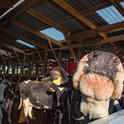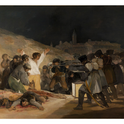I got up at 3am on a wet December morning in Paris, and walked down the deserted streets to meet Marwan Karouia who was going to take me to Rungis, the largest wholesale market for fresh food in the world. Marwan’s family hails from a village in the south of Tunisia, and runs my local greengrocer. “You will recognise our truck by all the graffiti,” his father Fathi told me.
Marwan is tall with a certain efficient speed about his movements. In the winter he goes to Rungis three times a week; in the summer the produce is more fragile in the heat and he goes more often. We drove through the entrance gates (visitors are welcome, but cannot purchase anything without a wholesaler pass) and found a parking space adjacent to one of the large open air halls. “There are 20 of these halls just for fruit and vegetables.” Marwan told me. “Then there is a whole area for meat, and others for fish, cheese and charcuterie. Rungis is a city. It’s better to get here early because otherwise there is nothing left to buy; the rarer things, like watercress, sell out early.”
The first hall we went into was for producers from the region around Paris. There was a stall selling truffles at around €1,000 a kilo. Roots and brassicas: potatoes, sacks of walnuts, beetroot, parsnip, chervil root, cabbages, cauliflower, Brussels sprouts. The fruit was limited to apples and pears. One stall specialised in salad greens and had an impressive array of trendy leaves: pink spotted lettuce, black curly kale and dandelion. I bought some oyster leaves which I had never tried before; blue green leaves, succulent, crunchy, with a subtle marine taste of oyster.
The other warehouse we visited was stacked with wooden crates of fruit and veg from all over France, Europe and the wider world. Much of the “summer” veg, like aubergines and courgettes came from Spain and Sicily and green beans from Morocco and Kenya. “Oh the French always have to have their haricots verts, no matter the season,” we laughed. Berries from Tunisia, Peru and Mexico, tropical fruits from Asia: bundles of blushing pink lychees, fuchsia dragon fruit, a peculiar yellow fingered citrus I had never seen before called the “hand of Buddha.”
Marwan moved between the two warehouses, zigzagging back and forth, comparing and contrasting price, colour, taste, and condition. “You walk kilometres every morning going back and forth,” he said. “Look at this basil: it’s not good and big now, it’s not the season.” Apples, he told me, as we discussed the banality of Granny Smith and the demerits of waxing, had been going up in price for several years. “They say it’s because there are fewer orchards.”
“It was better in the old days”
It was cold in the warehouses which were open on all sides so that air can circulate. Electric chariots piled with crates noiselessly trundled by. Marwan engaged a porter to follow after him picking up crates he had bought and taking them back to his truck on a hand pallet. There were almost no women; most of the men were Maghrebi; Marwan knew all of them. “That’s my cousin,” he said more than once. “Our family is a bit of a tribe with several grocers around Paris.”I noticed how clean the market was, not a scrap of rotting leaf or a squashed fruit underfoot. I noticed how carefully packed the premium produce was: a golden ribbon across the box of Sicilian Muscat grapes, pink garlic woven into long tresses, clementines wrapped in pretty tissue paper. I noticed that there were different brands. Some were international, like Driscoll’s, a big Californian berry behemoth that had its name on raspberries from Morocco, blackberries from Mexico and blueberries from Peru. Some were more specialised, like the French brand Blue Whale which primarily sells apples from its own orchards throughout France.
Every crate must be marked with the variety of produce and its country of origin, but understanding the relative difference in quality and value between one tomato and another requires experience and know-how. It’s not clear which brands are sourcing produce and which are growing it themselves and everything changes according to the season. Every day is different, prices go up and down, there are natural shortages, gluts. “You have to be vigilant,” said Marwan.
As consumers, we are increasingly asking more detailed questions about the provenance of meat and fish. Less so about our fruit and veg. Apart from organic or non-organic (there is a whole separate hall for organic produce at Rungis), information about the growing conditions and the supply chain is meagre and confusing. What kind of farm was the produce grown on? When was it picked? Has it been washed in chemicals, refrigerated, nearly-frozen, waxed, sprayed, irradiated? The websites for brands of produce are pretty dire. The wholesalers at Rungis were friendly, but not terribly forthcoming.
“It was better in the old days,” said Marwan’s father, Fathi, later that morning, reminiscing, “now it’s all just the bigger operations. But there used to be smaller sellers, local guys who came from farms directly, they would sit down and share a meal, have a cup of coffee. It was a different kind of atmosphere.”
Rungis replaced the famous Parisian market of Les Halles that was torn down in 1971 and is now an underground shopping mall. Les Halles itself was built in the late-19th century to replace Le Marché des Innocents where smallholders trundled into Paris each morning with their produce carried by donkey or in a small cart; carrots were sold along one street, turnips along another, potatoes along another and so on.
Markets are transaction and exchange, meeting places of goods and people and ideas. Wandering among the well-ordered, well-regulated produce at Rungis, I wondered what price we pay for efficiency and scale and convenience, how far have we separated our food from its origins, and what basic connections, to earth and life and people, have been lost along the way.












